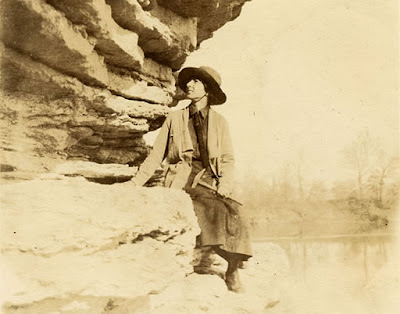Silk Blouse Pt. II
A continuation of our discussion of the 'blue' silk blouse. The pattern that this blouse was adapted from is a Butterick pattern from the 1940's. It seems to be post-WWII.
 This pattern came from a lot that I purchased by phoning in to a local auction house. It was a very bizarre and heavily mediated experience that somehow seemed more grounded than the process by which one purchases items off of ebay. The lot contained approx 28 patterns from the 30's and 40's along with about 6 from the 60s. The majority of the older patterns are in my size range (era specific size 12-14) and in a proportional range I believe to be more suitable to me than newer patterns.
This pattern came from a lot that I purchased by phoning in to a local auction house. It was a very bizarre and heavily mediated experience that somehow seemed more grounded than the process by which one purchases items off of ebay. The lot contained approx 28 patterns from the 30's and 40's along with about 6 from the 60s. The majority of the older patterns are in my size range (era specific size 12-14) and in a proportional range I believe to be more suitable to me than newer patterns.
I had used the pattern earlier this month to make a simple skirt out of some nice tweed scraps I had from a place I used to work. It is a very lightweight black/charcoal woven wool with white/red flecks. It is fairly loose, almost homespun looking, but with very fine yarns. It looks sort of like this:
The skirt came together with few problems. Since it is adapted from a dress, I sewed a grosgrain ribbon (from the same bag the blouse's ribbon came from) to the seam allowance and folded it over to create the waist. The zipper is gray aluminum 7" ykk I got on clearance (in a pack of 30 different colors) from a cleaners supply website. I thought that I would have to use both <1 yard pieces to make the skirt, but I was able to cut it from one, leaving me with the extra piece for a future coordinated garment. After making the tweed skirt, I thought that I might attempt the blouse portion with the blue silk. It seemed to be a nicely balanced office-oriented sort of look, perfect for subtly dismantling perceptions of female professionals when paired with my activities. More 'film noir' than 'Mad Men'. It ended up creating more of a young and elegantly frumpy 1920's naturalist, which I can also get behind.
 |
| (img Isabel Bassett, from http://www.pbs.org/nationalparks/media_detail/429/) |
Although very problematic within its own context, I find the different measures of austerity, dressing etiquette and conventions of the early part of the 20th century to be endlessly fascinating. I consider the performance of various identities within a culturally and chronologically 'inappropriate' context to be very exciting, although often subtle and unrecognized unless by blog or social engagements in a realm of fashional importance.
There are many who pine nostalgic about the clothing and lifestyle of past eras in a way that I admire but duly makes me cringe when they exist casually (countless statements from vintage lovers along the lines of "I live a retro lifestyle, and love being a homemaker, taking care of my husband, looking beautiful and fulfilling my feminine roles") but I know, in present times, have transformative capacity. Often these processes are enacted by the ones previously mentioned, and despite the complications with feminist discourse, they grapple, albeit clumsily, with manifestations of anti-consumerist sentiments, re-evaluation of the quality and potency of everyday objects, serious considerations of gender roles in a way that feels [to them] an act of agency, not dictated by contemporary social conventions.
While I often feel conflicted about these surface level negotiations of notions of change and time, I also admire them. Part of me feels a bit old school and wants to shift the weight of this issue onto the importance of consciousness raising. However, I suppose this drive within me operates in a similarly surface and romantic, only notionally nostalgic, past social systems ie: early feminism. In that sense, the reaction I have to these modes 'unconcious' of historical appropriation are similar to the reactions directed towards second wave feminists.
 |
| (img from http://www.fiber-images.com which features free sewing tutorials) |
Metaphorically, it feels a bit like the bias-tape designated mobius strip, born of a cyclical nature and ultimately configured to exist in a linear fashion to be applied conventionally.
Anyway, here is the outfit:


